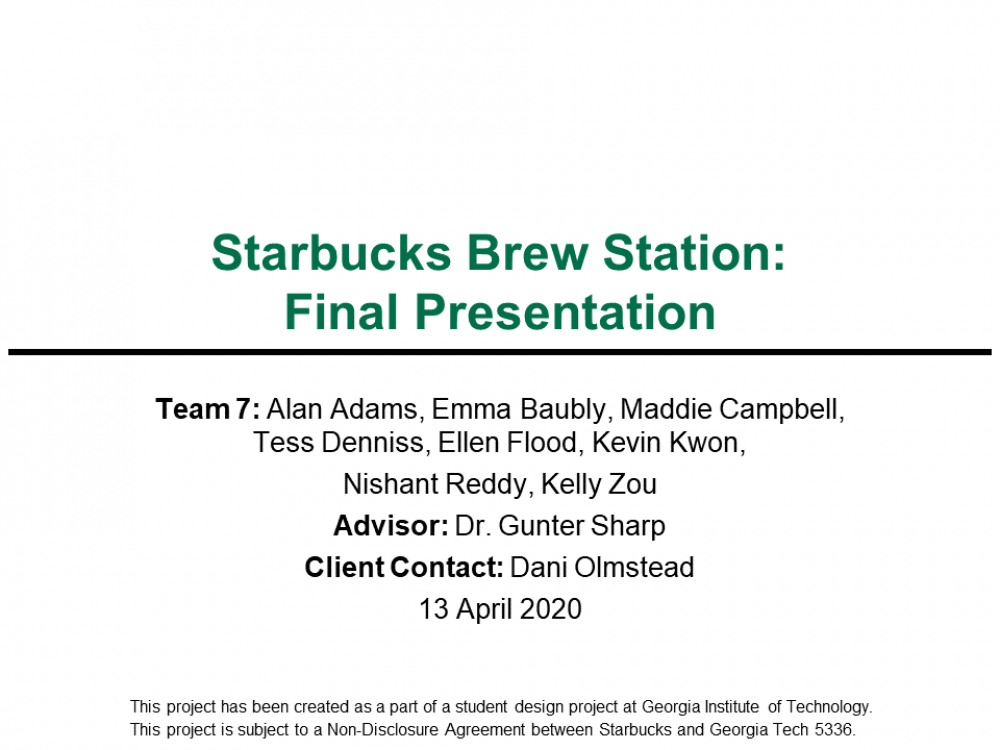Client Context
The Starbucks Operations Engineering and Innovation Team manages functional design for 9900 corporate-owned stores in the United States and Canada. This includes designing equipment recommendations, station layouts, and brew station configurations. They work cross-functionally with the ultimate goal of designing stores that are efficient for the baristas, pleasant for the customers, and profitable for the business. The focus of the project is the behind-the-counter brew station in Starbucks corporate-owned stores. The brew station is the largest single area behind the counter, and it contains Double Bunn Brewers, shuttles, and shuttle stands. Coffee is brewed in Double Bunn Brewers into shuttles, where coffee is stored and poured. Shuttles must sit on electric heated shuttle stands when not in the brewer. There are three coffee roasts: Pike, Dark, and Blonde, all of which must be available at all times during the peak hours of 7 to 10 AM. Coffee expires 30 minutes after it is brewed. Baristas follow a brewing schedule, which currently tells baristas to brew a roast every 10 minutes.
Project Objective
Although there are 9900 stores, Starbucks currently recommends one of only three equipment combinations of Double Bunn Brewers (DBBs) and shuttles to each store based on its peak demand. 80% of stores are recommended the same equipment level: 1 DBB and 6 shuttles. Analysis showed that many stores with this amount of equipment could not meet demand with the current brewing schedules, and many stores with this amount of equipment have the capacity to brew much more than their peak demand requires. Additionally, while stores may have the capacity to meet total demand, they may not have the capacity to meet the demand for each roast.
The objective of our project was equip stores with the minimum amount of equipment needed to meet peak demand.
Design Strategy
We first started with shuttle visualizations to manually simulate how roasts and shuttles move through the system, creating feasible schedules. This informed us that if baristas brew more often, then they can produce more coffee, and stores require a minimum of 4 shuttles to have all 3 roasts available at all times. It also highlighted that different demand distributions among the 3 roasts require different equipment levels. To validate the shuttle visualizations, we calculated capacity of various equipment levels and roast distributions with a constraint programming model. This model maximizes the time coffee is in the shuttles (subject to the constraint that it expires after 30 minutes) to minimize barista labor. Finally, we created a Python tool to match stores to equipment levels by finding the minimum equipment level with capacity that exceeds peak demand at the store.
Deliverables
The primary deliverable for this project is the Equipment Recommendation Tool. The Starbucks Data Analytics team will run the tool every 2 years to revise equipment recommendations to reflect changes in demand.
Starbucks was also given a CSV file of revised equipment recommendations at different service levels for existing stores as of April 2020. This file will be used to determine how many shuttles, shuttle stands, and DBBs should be replaced as they break or approach the end of their lifespans.
A manual explains the usage and capabilities of the Equipment Recommendation Tool. This manual will explain how to run the code and interpret the output.


